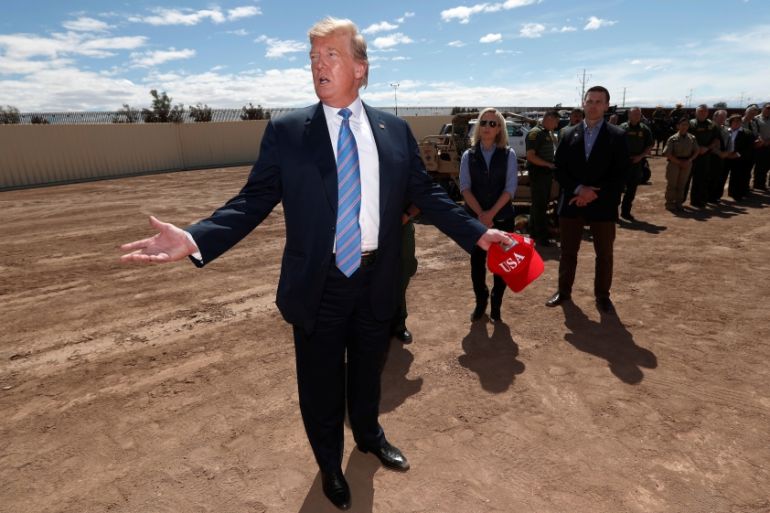Donald Trump found a different way to build his wall
The Trump administration is using a wide range of cruel policies to stop people in need from seeking safety in the US.

President Donald Trump’s obsession with building a wall on the United States-Mexico border knows few limits – he reportedly even entertained extreme ideas such as building a moat over the border and filling it with alligators. This is why when it became apparent that his administration was not going to succeed in erecting a complete physical barrier on the border, the president found a different way to “build the wall”: inhumane asylum policies.
The Trump administration has advanced a wide range of cruel policies that have stymied the internationally-recognised right to seek asylum. The bricks in Trump’s border wall take several forms: “metering”, which constricts the number of asylum seekers who can apply on any given day; the so-called Migrant Protection Protocols, which require asylum seekers to remain in Mexico while they wait for their cases to be processed, and; the Safe Third Country Agreement, which requires migrants to apply for asylum and get rejected in a country they transit through before seeking asylum in the US.
Keep reading
list of 4 itemsAdvocates gird for Texas migrant law that could upheave US immigration
US appeals court blocks Texas from arresting and deporting migrants
‘Incendiary and wrong’: Biden spurs anger for calling migrant ‘an illegal’
Trump also boasts that he is “using Mexico to protect our border,” as the administration weaponises the trade and economic leverage it has over Mexico to effectively outsource US immigration enforcement to its southern neighbour and other countries in Central America.
I have seen first-hand the devastating impact of these policies on people who are in dire need of help and protection.
Earlier this year I led a team of doctors on a field investigation to Tijuana, Mexico, where we interviewed asylum seekers about the experiences that drove them to flee their homes and seek protection in the US. Our investigation, published earlier this month, documents medical evidence of the violence these asylum seekers survived. Their physical and psychological scars corroborate their testimonies of persecution.
I witnessed how the Trump administration’s asylum policies are contributing to the suffering of these already-traumatised people. He could not literally build a wall, so he decided to leave thousands of asylum seekers from around the world stranded on the Mexican side of the border. His administration has created growing migrant encampments – refugee camps in the making. Some 60,000 asylum seekers are currently stuck in Mexico, exposed to further violence.
One important component of Trump’s “wall” is expanding the practice of metering, severely restricting the number of asylum seekers who can be processed at a US port of entry on any given day. For example, the San Ysidro-Tijuana port of entry processed between 40 to 100 asylum seekers per day in 2018. This year, it has been processing just 25 per day. This practice has created a massive backlog of asylum seekers who are then placed on a waiting list. One of them is Natalia*, a woman we interviewed in Tijuana.
Natalia was a schoolteacher in Mexico who dreamed of one day running a daycare centre. Her husband repeatedly physically and sexually assaulted her and beat their young children. She tried relocating within Mexico to escape his death threats, but he eventually found her and told her he had sold her and her children to organ traffickers. Natalia immediately fled to Tijuana, where she tried to make an asylum claim. But she was told to “get in line”. With no food or money, Natalia waited for months in Tijuana for her turn to request protection in the US.
Trump then built his wall higher with the third-country asylum rule, which requires asylum seekers who travel through a “third country” en-route to the US to apply for asylum and get rejected there first. In practice, this bans asylum claims at the US-Mexico border for all nationalities except for Mexicans, who do not have to travel through a “third country” to reach the border. For example, an asylum seeker named Sergio*, whose family was targeted by gangs in Honduras, told me that they fled to Guatemala after they were attacked by men with machetes. But once in Guatemala, the same men found Sergio’s family. With their lives in imminent danger, how could Sergio’s family be asked to apply for asylum “protection” in Guatemala?
These punitive policies stem from President Trump’s antipathy toward migrants and inability to realise his border wall fantasies. While they may not have been able to build a complete wall on the US’s southern border, the Trump administration has made it virtually impossible for most asylum seekers to request protection in the US. The human toll is clear: tens of thousands who have fled persecution in their home countries are trapped along the US-Mexico border, vulnerable to further trauma and exploitation.
The right to seek asylum is a human right, protected in both US and international law. The US needs a government that safeguards that right, not one that constructs policy barriers when so many lives are on the line.
*Names changed to protect asylum seekers from reprisals
The views expressed in this article are the author’s own and do not necessarily reflect Al Jazeera’s editorial stance.
